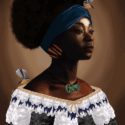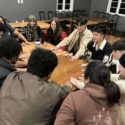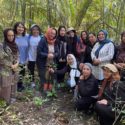For the last 25 years, members of Auckland’s Aotearoa Latin American Community (ALAC) have enriched Tamaki Makaurau and Kirikiriroa with their artistic and political activism and community action.
They came here from countries, and communities, as diverse as any in the world. Many were refugees or people who migrated to start new lives away from political oppression and violence.
It’s natural for them to reach out and support recent refugees from Africa and the Middle East, many of whom are indigenous to the countries they’ve been displaced from. Their experience of injustice in their homelands left them clear eyed about the history, and grievances, of tangata whenua as well.
Collaboration creates holiday programme
Last summer they spearheaded the Project Tamkin holiday programme in collaboration with E Tū Whānau, the Mangere East Learning Centre and Manukau AFC. E Tū Whānau kaimahi Jenny Janif, was one of the organisers.
“It was a real success because it gave these tamariki from different cultures and different parts of Auckland a chance to explore Mangere East, to understand the environment they live in and how to care for it.”
The Project Tamkin holiday programme took Muslim tamariki from Mt Roskill to South Auckland where they met new people, ate delicious Latin American food, played a range of sports and, importantly, were taken on field trips to understand more about their city.
Getting to know their city
One of the places they visited was Ihumātao at the time of its occupation by whānau objecting to its use for a housing project.
Qiane Matata-Sipu welcomed the tamariki to the site, told them about the history of the area and why she and others were occupying it.
She said that welcoming diverse community groups, especially tamariki, was an opportunity to share the stories that need to be shared to keep those stories alive.
“When our children come to experience these things and learn about them, it helps them make better decisions about the future,” she says.
Cross-cultural projects
ALAC founding member, Esteban Espinoza couldn’t agree more. He points to the ‘Sewing Travelling Box’ and its offshoot ‘The Tamkin Project’ as examples of how cross-cultural community projects developed by ALAC have led to enduring personal relationships that start with sharing, sometimes harrowing, stories.
Both projects started when Argentinian artist, fashion designer and fashion sustainability advocate Victoria Martinez Azaro brought African and Middle Eastern refugee women and Latin American textile artists together to create textile art telling their personal stories of migration.
“These projects drew women from different communities together to create a welcoming environment in which immigrant women can to tell their stories and explore the journey of migration through textiles,” says Esteban
“Stitching memories into cloth”
On her website, Victoria describes the project as a way for the women to sustain their language while stitching their memories into a piece of cloth that keeps growing.
“I know first-hand that when you arrive in a new country, no matter the surrounding circumstances, you are forced to evolve, develop and review your position in the world.”
“In my case, this generated a main shift in my own identity which created a horrible sense of dislocation, disengagement and an identity crisis which took me many years to overcome.
“This project gave me the opportunity to make other women’s journeys a little bit better and to share my own story of migration with them.”
The textile art created by the women was part of a mixed medium arts exhibition by migrants and refugees from the 12 countries of Latin America and from Africa, the Pacific and the Middle East, will exploring themes of Migration and Identity held in Auckland in 2019.



